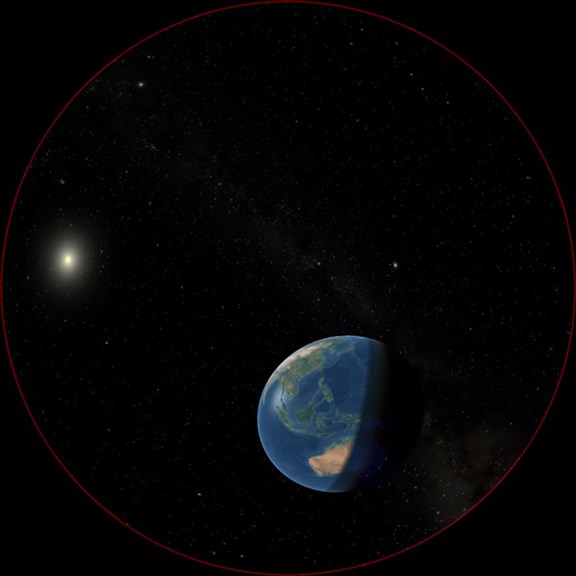Changes in the sky
The image below provides a space view of Earth against a background of stars. Teachers may use this image to prompt discussions about day and night.
Learning outcomes
In this activity children will:
- be able to describe that night and day are caused by the rotation of the Earth
- recognise the Sun as a source of light and heat
- observe evidence of humanity's presence on Earth.
Engage
The following questions may be used to engage students in the provided image. Discuss the supplied image in conjunction with animations of the Earth rotating.
- Tell me two important things about the Sun.
- Tell me two important things about the Earth.
- What do you think this image shows us?
Explore
- This image is a space view of Earth. What do you think is meant by the term 'space view'?
- What would you call a view from Earth? (An Earth view)
- What differences can you see between the half of the Earth in daylight and the part that is in night?
- Imagine you are at home just as this picture was taken. Would you be experiencing day or night?
- What changes might you see in the sky over the next hour?
- If you were sitting outside in Perth (indicate where Perth is), what would the conditions be like (e.g. bright or dark, hot or cold)?
- What differences would a person in Melbourne experience?
- What other regular changes occur throughout the day as we experience day and night? Via a class-led discussion, explore student understanding of other regular changes such as temperature, amount of light, sunrise and sunset.
Explain
- The supplied image shows that the half of the Earth that faces the Sun is illuminated, whilst the other half is in darkness. The Earth completes a rotation on its axis once every 24 hours. On Earth we experience day and night because the Earth rotates while the Sun stays in the same location.
- The Sun is an energy source for our planet. It provides light that distinguishes day from night. It also produces heat, which warms the Earth.
- To us on Earth, the Sun appears to move across the sky, travelling from east to west. This is because the Earth is rotating from west to east.
- It is the rotation of Earth that makes it appear as though the Sun is moving across the sky.
Elaborate
- Model day and night using an Earth globe.
- By making use of available technology, view and discuss animations of the Earth's rotation found at the Visible Earth website.
- Students to make a simple audiovisual presentation describing how they experience day and night.
Evaluate students' understanding
- Pose the question: 'What causes the Sun, Moon, and stars to rise in the east and then set in the west?'
- Discuss these observations as a class and challenge students to model this with a simple Earth globe.







